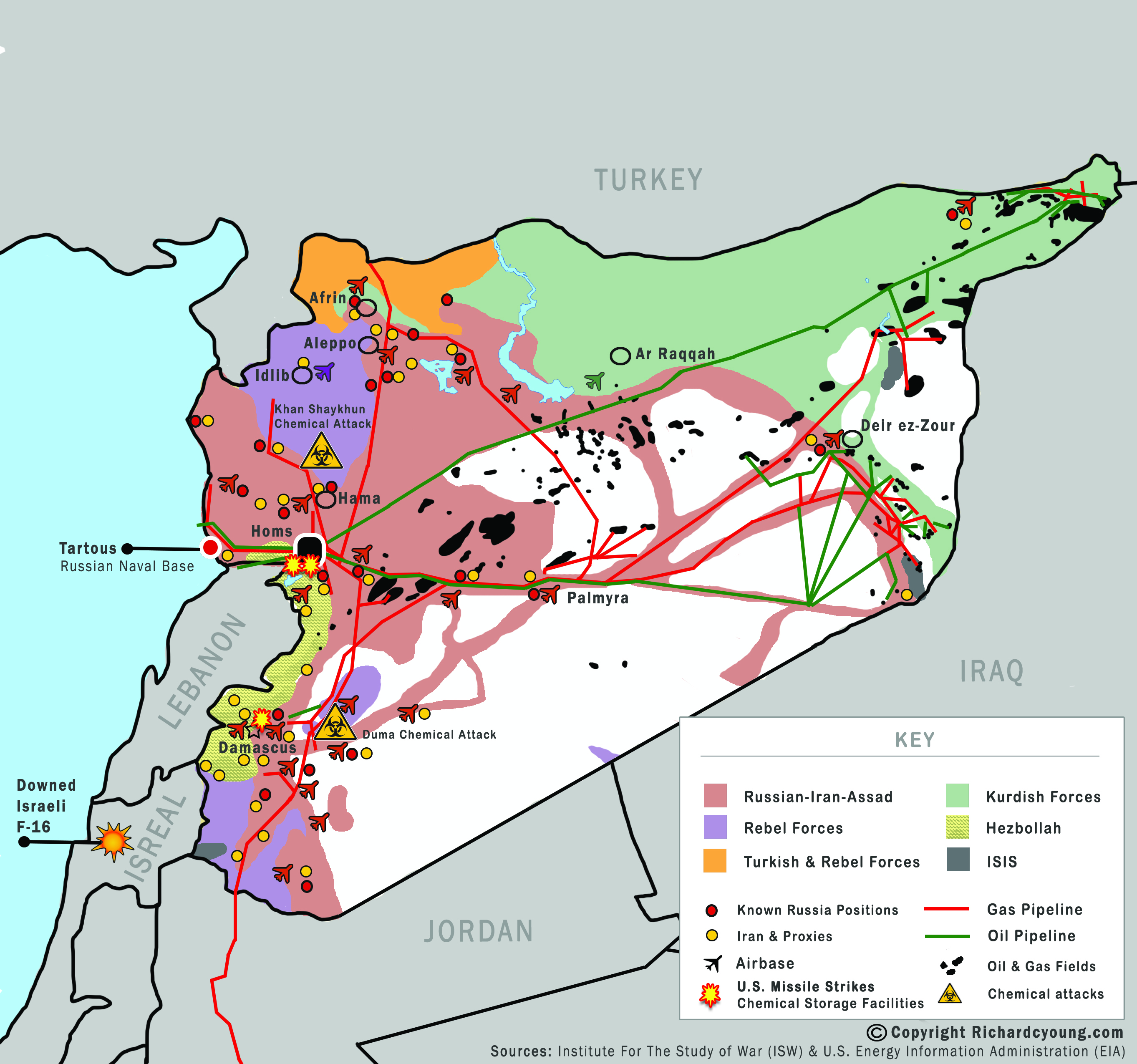
As you can see in the map above, the Syrian civil war has many fronts and many players. Those fronts are increasingly more complicated as outside forces are getting increasingly involved. As Haaretz explains in “Syrias Four-Front War and the Unprecedented Chaos It Has Created,” the recent chaos has seen al-Qaida rebels shooting down a Russian jet, Kurdish fighters downing a Turkish helicopter, Israel downing a Iranian drone, and the Syrian army shooting down an Israeli F-16, all within a week. Below, Haaretz breaks down these Syrian Fronts.
1) Turkey’s war on the Kurds
Turkey opened a new front in Syria’s nearly 7-year-old war on Jan. 20, launching an offensive against the U.S.-backed Syrian Kurdish militia in the northwestern enclave of Afrin. It is the latest effort by Turkey to limit Kurdish expansion along its border with Syria and aims to drive out the militia known as the People’s Protection Units, or YPG, which Turkey considers to be a “terrorist” organization.
The Turkish campaign has strained relations between NATO allies Ankara and Washington, which has partnered with the Syrian Kurds in the fight against the Islamic State group. Turkey’s president is threatening to expand the offensive east, toward the town of Manbij, where U.S. troops maintain bases, while U.S. officials accuse Turkey of hampering the fight against IS with its Afrin operation.
2) Assad’s war on the rebels
The Syrian government and its ally, Russia, have in the past two weeks dramatically escalated attacks on two of the largest and most important remaining opposition-held areas, in Idlib province in northwestern Syria and on Eastern Ghouta, a besieged area near the capital of Damascus.
The sprawling region, where rebels launch rockets on Damascus, has been a particular thorn in the government’s side for years, and Assad appears determined to recapture it at all costs.
3) Israel’s war on Iran
The downing of an Israeli fighter jet this weekend by Syrian air defenses suggest yet another frontier in the conflict is opening up, risking a wider and possibly regional conflagration.
Israel, which has struck targets inside Syria more than a 100 times in the course of Syria’s war, with raids often launched from neighboring Lebanon’s airspace, has been warning of an Iranian buildup in Syria for months, vowing to prevent Tehran from building bases near its border. On Saturday, Israel’s military said it shot down an Iranian drone that took off from a base in Syria and infiltrated Israeli airspace. It carried out about 12 strikes targeting Syrian army and Iranian sites in Syria before Syrian air defenses shot down an F-16, marking the first time an Israeli jet was downed since 1982.
4) U.S. war on ISIS
The U.S. policy in Syria has always been vague and often inconsistent. But earlier this year, U.S. officials confirmed Washington’s intention to keep troops indefinitely in northern Syria even after the defeat of IS. The U.S. says it seeks to prevent an IS resurgence as well as to counter Iranian influence in Syria.
But as IS shrinks, the estimated 2,000 U.S. troops stationed in Syria find themselves caught in a highly unpredictable and shifting battlefield, as demonstrated by an unexpected attack by pro-Assad fighters on U.S.-backed forces who were accompanied by U.S. advisers in Deir el-Zour.
The U.S. responded with a deadly barrage of bombs and artillery that U.S. officials say killed about 100 of the attackers. Russian news reports said Tuesday that an unknown number of private military contractors from Russia were among the dead, illustrating the risks foreign forces face on Syria’s crowded battlefields.
Many of the U.S. troops in Syria are operating with local, Kurdish-dominated allies known as the Syrian Democratic Forces, in the eastern oil-producing Deir el-Zour region along the Euphrates River. The area had been a stronghold of IS militants until late last year.
But they are competing for control of Deir el-Zour with Russian-backed Syrian troops that are reinforced by Iranian-supported militias.
Keeping U.S. forces in areas that Assad’s government hopes to reclaim inherently increases the probability of more clashes.
On Tuesday, Russia’s foreign minister accused the U.S. of trying to create a quasi-state in eastern Syria.
Read more here: Haaretz
E.J. Smith - Your Survival Guy
Latest posts by E.J. Smith - Your Survival Guy (see all)
- A Word on Stocks - July 26, 2024
- Is Vanguard Too Big? What’s Next? - July 26, 2024
- Boomer Candy? - July 26, 2024
- My BEST Insider’s Guide to Key West - July 26, 2024
- Having Fun Yet? Nasdaq Worst Day in Years - July 25, 2024














